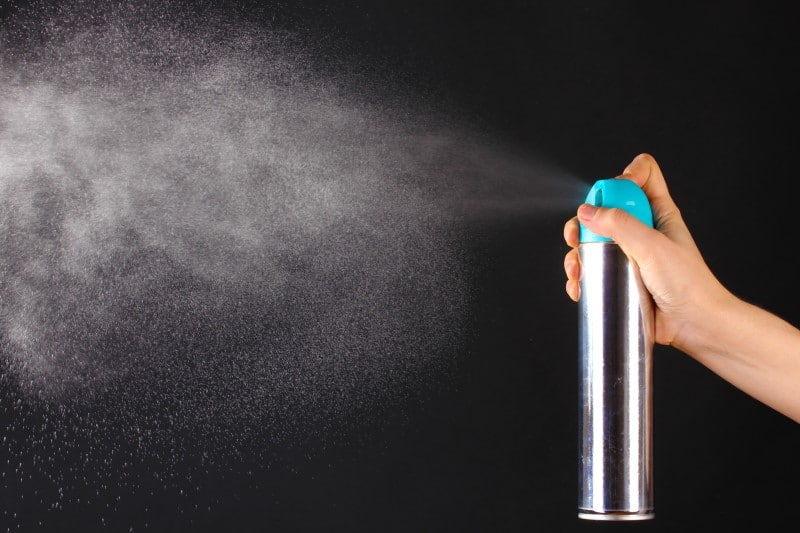There are so many types of air fresheners these days; they fill nearly an entire aisle at the grocery store! Have you ever wondered what classification air freshener falls into: gas or liquid?
Air freshener is both a gas and a liquid because they are what is called a volatile substance—a chemical that vaporizes readily. Air freshener in a can is an aerosol, which means it is a scented liquid that is kept under pressure inside the can. This liquid dissipates into the air when sprayed, quickly becoming a gas.
In other words, the air freshener itself is a chemical liquid inside the can but is activated when the spray button is pushed, releasing a cloud of liquid vapor that rapidly converts into gas. When your nose detects the air freshener, that is the fragrance molecules you are sniffing. Air fresheners do just what they advertise: they freshen the air.
If you shake a can of air freshener, you can hear what sounds like liquid sloshing inside, but it comes out like a quickly disappearing mist! Curious and curiouser… let’s investigate!

Are Air Fresheners Safe to Inhale?
While air fresheners are indeed safe, they are only considered safe when used as directed on the packaging. The chemicals used in aerosols are fairly common in the household and the workplace, and are always to be kept away from children because they can easily be abused. This is officially called volatile substance abuse (you may have heard the terms glue-sniffing or huffing).
This can also happen by accident, which is why it’s important to have enough ventilation when using chemicals. If you’ve ever felt lightheaded while cleaning a small bathroom, and had to go outside for fresh air, that could have been the start of this process. Lightheadedness won’t be an issue with air fresheners if you use them according to the directions. Another thing to be aware of is that pet birds are very sensitive to air fresheners and easily be paralyzed or even killed if they are too close to the air freshener.
So now we understand how and why aerosol air fresheners are liquids that turn into gas. But what about other types of air fresheners—non-aerosols? Are they also liquids that turn to gas, without the pressure in the aerosol can to dispense them? And what in the world is up with solid air fresheners? Do they turn into liquid or gas?
How Do Other Types of Air Fresheners Work?
- Air freshener in a bottle with a pump-style dispenser
- Reed diffusers
- Plug-in oil fresheners
- Solid air fresheners
A pump style bottle of air freshener works the same way, but without the chemical aerosol. This liquid isn’t under pressure at all—you are able to unscrew the pump lid at any time and see the liquid, whereas the pressure in a metal can of aerosol would cause it to explode if it were punctured.
You may have noticed on an airport checklist that airplanes do not allow aerosol cans in baggage. Not just air fresheners: this rule affects hairspray, deodorant, body spray—anything that is propelled by aerosol. The reasoning for this rule is because the pressure of flying could cause the can to explode.
The pump-style bottles of air freshener and hairspray are totally safe for flying, though. And these bottles are still very effective! The manual force of your thumb on the pump pushes the liquid through the air—maybe not as vigorously and wide-reaching as the can aerosols, but without the chemical reaction of aerosol.
Many consumers prefer this for health reasons—asthma can act up with aerosols—or for environmental reasons. These pump-style bottles can be refilled with the air freshener liquid, so if you find a company that sells the refill liquid, you can reuse the bottle instead of having to throw it away, as aerosols require when empty.
With the plug-in type of air freshener, you can see the liquid oil inside the glass container, but it just slowly disappears over weeks without being seen. The reed diffusers feature a bottle of oil, the level of which slowly goes further down until it’s completely gone. How and why does this happen?
Other types of air fresheners, like reed diffusers and plug-in oils, work a little differently. They are still liquids that turn into gas, but not through the aerosol method. These use simple evaporation to get into the air. The plug-in models work faster to get into your sniff-zone and smell more strongly because they have the advantage of being activated by heat, whereas the reed diffusers evaporate slowly.
These air fresheners, depending on the brand, contain either essential oils or chemical compound fragrances, or perhaps a mixture of the two, dissolved in a solvent such as alcohol. The evaporation of the solvent helps dissipate the lovely fragrance throughout your home, but you only smell the fragrance, not the solvent.
Solid-style air fresheners also come in different forms: beads and gels are the most common. Gels can be in a small tray that attaches to a car air vent. The air conditioning or heater blowing on the gel circulates the scent throughout the car. Gel air freshener also comes in a short plastic container that twists open to release more or less of the scent.
This kind of air freshener was more common before the plug-in sort was invented and before diffusers were widespread. The actual solid air freshener is a colored gel. At first, only a small twist open is needed for a nice scent filling the air of your home. But as the solid air freshener inside wears down, you will need to twist the container further open to keep up the same level of scent.
Why Does the Gel Wear Down and How?
The fragrant gel substance disappears slowly, through a process known as sublimation. This process is similar to our liquid air fresheners changing into a gas, but instead, it is a solid changing directly into a gas, bypassing the liquid stage completely.
Dry ice is another example of sublimation; dry ice is solid and goes directly to a gas form without ever melting as regular ice cubes do. Both solid air fresheners and dry ice have long been mainstays of chemistry teachers to illustrate the process of sublimation.
Solid style air fresheners are recommended to be kept high on a bookshelf or somewhere that children cannot reach them. The gel is attractive, resembling a bright jelly, and it is toxic. Thankfully the formulation tastes unpleasant, so it is unlikely a child would eat enough to do more than vomit. Nevertheless, poison control should be called with any amount of ingestion.
The air fresheners with gel beads are perhaps even more attractive to children, and present a different type of risk, as the beads are easy to swallow and can be swallowed a handful at a time. The swallowed gel beads would then release toxins slowly as they are digested. Again, it is important to call poison control for any suspicion that a child has eaten any air freshener in whatever form.
Sublimation, Volatile Substances, Gas and Liquid: oh my!
We answered the question of “gas or liquid” and more! Remember: if air fresheners are used as directed, you can feel confident that your home is safe and always smelling its best, thanks to the magical properties of air fresheners. What a fascinating substance this is, that can change at a press of a thumb or a twist of a container. But the most important thing? That you love the scent that fills your home!
